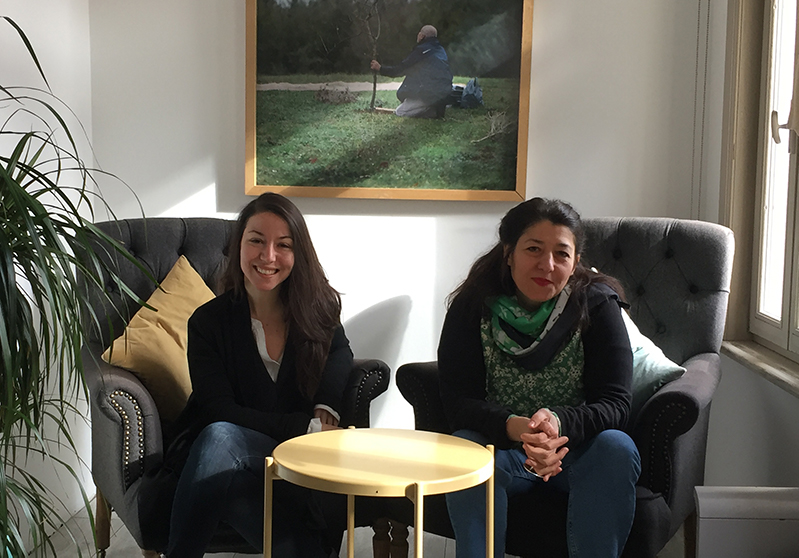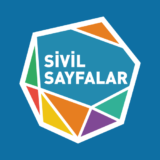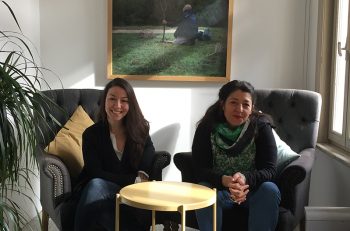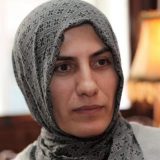“Sharing Art Instead of Presenting”

"Seçil Yaylalı and Zeynep Okyay, whose work we talked about, especially the Sözden Öte project stated that is an artist initiative run by two artists and two cultural managers, which includes participatory and socially oriented art projects and their point points of view is as "sharing an experience instead of presenting art."
What is PASAJ?
Seçil Yaylalı: PASAJ is an artist initiative run by two artists and two cultural managers, which includes participatory and socially oriented art projects… We host exhibitions, interventions, workshops, speeches, performances of local and international artists. We can say that it is a structure that seeks ways to facilitate the exchange of experience and skills, trying to create an environment in which artists can encounter different communities. As an initiative that respects the local knowledge, history and memory, it explores ways to exist in public and semi-public spaces, associating art in various formats with some city locations. The PASAJ, which has been relocated five times since 2010, is being reshaped. Each time it was connected with the local area in which it is located. It is now located in a historic inn in Karaköy. It has project/exhibition series and their meetings under the name of “Aklımı kurcalıyor, ruhuma dokunuyor” in 2019-2020 program. Supported by Roberto Cimetta’s Tamteen fund, this program aims to focus on “artistic freedom of expression” and “memory of space.” We are a member of AIM (art formations run by artists) network since July 2019.
What is the main motivation of PASAJ? Both when it was established and when it carried out its work…
Zeynep Okyay: The main motivation of PASAJ in the establishment process was to make space for the artists who do not have visibility and do not meet with the audience by organizing short-term events. There are criteria that galleries and commercial organizations or museums expect from artists. Apart from these criteria, the ability to create more space for the artist to move and perhaps meet the artist who is not highlighted by the system with the audience, was to add something to his own practice by sharing his experience. The PASAJ had to change from the day it was established in a way it was necessary to continue. What we have been working on for a long time is to take art out of the way we are used to seeing it all the time and to touch everyone beyond the audience we are used to as an art audience. Creating a meeting through art.
Is your work understood, both from the point of view of art circles and by the masses you are trying to reach?
Zeynep Okyay: We believe that we can convey our own experience. The experience of PASAJ shaped as a need. We were in a 27m2 hidden room in the passage at the end of the stairs. There weren’t many spectators. So we said, ‘Are we going to wait for the audience to come or are we going to make a connection with the Halep Passage in which we are established?’ One of the projects that we have included in the program with this concern is the Urban Garden Lab in 2011, created by Seçil Yaylalı and Isa Andreu. In addition to the exhibition, there were parallel events with the shop owners inside the passage, and a flow of many artists was organized through the Corridor Conversations program. In the participatory project named “Herkes Kendi İşinin Ehli” in this program; shop owners in the passage came out and made statements about how they spend their one day, what they need and what they like to do, how they continue this place, what their concerns are. When the people of the passage communicated with each other, we contacted them in this way.
So can we say that there are two main concepts? The first is to support the works of artists who do not have a place and the second is to carry out projects that will involve the masses who cannot reach the arts.
Seçil Yaylalı: We want to share an experience with a community rather than presenting art to an audience. Our goal is not to explain what art is but to experience it together. Creativity is something to enjoy and the creative process is also about questioning and making it a part of life. In our PASAJ Tarlabaşı project, the artists were producing in a corner of the restaurant, and those who came there to eat became part of it. So it was possible to intertwine organically. This creates a complete exchange environment. The artist says, ‘Let’s do this together’ and suggests something when a sharing begins. Sometimes it becomes one-to-one material exchange, sometimes the material equivalent is emotional. Of course, you can see the impact of this exchange over the years, not in one day. Then you see that you can touch the people who live around us. This is an indicator that proves that our work is worth it.
Choosing a pasaj as a name… Maybe indicating spatial transformation?
Zeynep Okyay: When we were in the Halep Passage in İstiklal, we had Demirören right next to us. We were in a place where we could both see the transformation of trade and be a little bit out of it. On the one hand, big brands and on the other hand, some sectors trying to maintain their commercial movements more minimally. I see this very parallel to the attitude we take. There were a lot of things we could learn from those shop owners. Because we have the same concerns on different lives. For example, there was a small shoemaker who tried to keep his job. On the one side big chain stores, and on the other side that shoemaker trying to make his own custom-made shoe number 46. In the passage, there is Beyoglu Movie Theater and Ses Theater. We already fit there a lot. Both as an idea and as a positioning. Now our place here is the same. We are experiencing another version. In this inn, everyone knows and helps each other from A to Z. So we are very excited to work on the memory of this inn. When I thought about what we could do in Karaköy, we said, ‘Let’s work on a memory, these inns will become hotels after Galataport’ and when I was a little, I saw this place with my father, and at that time, during Ramadan, the tables were set together, and backgammon was played together. So this is a culture,and the extinction of this culture is very soon. The location of the PASAJ here is closely related to where it first looked.
Well, can you give some information about relationship of Pasaj with the city? You worked in Tarlabaşı and Bayrampaşa.
Zeynep Okyay: When we go to a new place, we try to pay attention. We are trying to match the texture of that area. When we settled in Tarlabaşı, we realized that we were in a structure that could be from Tarlabaşı. Because we are also in a disadvantaged group compared to popular art environments. We don’t want to be like mainstream art spaces, nor we can. We’re in the middle of two. Although Tarlabaşı looks like an area in the center of the city, it is like a small village. At different times of the day, a mawlid is recited in one corner of the neighborhood, the roundabouts are thrown in the other, the children are outside. Every street is another world. You are experiencing the rarest experience you can see in Istanbul. This colorfulness of Tarlabaşı will of course be left behind with gentrification. And we thought, “Where can we get rid of this colorfulness, how can we put this experience on the agenda of the artists”. And we have included projects, exhibitions and works in this way for a long time. One of them is a project where Seçil Yaylalı and Ekmel Ertan shot documentation films of children and their neighborhoods, for example. Children are the most accessible and open to art group. They worked together, interviewed people in the neighborhood, and they were all movies. They started asking what we were going to do now when the project was over. We had 50 square meters of space on the third floor and we used this place. We called this place PASAJ Tarlabaşı in cooperation with the restaurant at the beginning of the street. We invited artists from different countries of the world to make artistic interventions here and each artist continued to do workshops with children from where we left off.
In Bayrampasa, we started a residence by the invitation of Ramada Encore Bayrampasa Hotel. Our artists were guests at the hotel for two weeks and conducted research on various topics related to Bayrampaşa. At the end of the 3-year period, we exhibited the results of these studies in our field in Karaköy. Thus, the transformation of the city was reinterpreted by the view of the artists.
There is also the Sözden Öte Project that you are running now. Could you give us some information about it?
Seçil Yaylalı: Sözden Öte is a cooperation project initiated by three teams from Sweden, Denmark and Turkey who have worked with each other in the past. We carry out this project under Erasmus+ in partnership with associations and institutions from these two countries as PASAJ. It is practiced with kindergarten teachers and artists working in the neighborhoods of Rinkeby in Stockholm, Gellerup in Aarhus and Tarlabaşı in Istanbul. BIS, who also represents PASAJ from Turkey, Kültür University Pre-School Education Program and Tarlabaşı Community Center are with us. Our aim in the project is to reach the kindergarten teachers in these neighborhoods with similar characteristics and to design a gender equality-oriented toolbox with their participation. Some workshops were held in Sweden and Istanbul within the scope of the project. We aim that the tool bags that will be produced in these workshops will be a resource for teachers while providing gender education in kindergartens all over the world. There are pedagogical and scientific support teams for example, Dr Nil Mutluer working on gender equality at the Humbolt University of Berlin within the PASAJ Studies are carried out on how the method can be applied with children, how different methods can be developed and how the practical application material can be educational material in toolbox format. After the workshops, the project will be completed with seminars, books and exhibitions.
What kind of work do you have on sustainability?
Zeynep Okyay: Sustainability is one of our main items on the agenda. Since there will be no institutional sustainability as we know it, all changes in political, economic and social structure affect our sustainability. We are trying not to narrow our field of movement and on the other hand we are thinking about creating an alternative economy.
Are there any solutions you’ve found?
Seçil Yaylalı: Once a year, we have an exhibition where we create a support fund with the productions donated to us by the artists and its name is Çorbada Tuzun Olsun. We have held this exhibition 7 times so far. In addition, we implement EU projects and apply for funds. But it should be underlined that when we look at the world, the artist initiatives and the independent art spaces are not very long-lasting movements. Despite this, we will try to continue as much as we can. As long as we have the desire and energy, we think we can develop methods and continue. We walk along this path with not only four people but many valuable people who support us spiritually.



Bizi Takip Edin